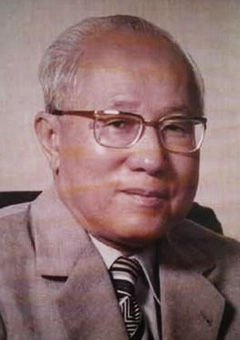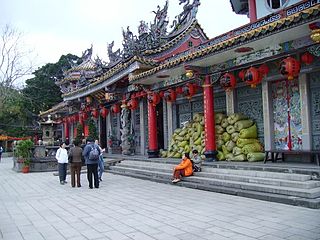
The Peranakans are an ethnic group defined by their genealogical descent from the first waves of Southern Chinese settlers to maritime Southeast Asia, known as Nanyang, namely the British Colonial ruled ports in the Malay Peninsula and the Indonesian Archipelago, as well as Singapore. Peranakan culture, especially in the dominant Peranakan centres of Malacca, Singapore, Penang, Phuket and Tangerang, is characterized by its unique hybridization of ancient Chinese culture with the local cultures of the Nusantara region, the result of a centuries-long history of transculturation and interracial marriage.

Chen ( ) is a common Chinese-language surname and one of the most common surnames in Asia. It is the most common surname in Taiwan (2010) and Singapore (2000). Chen is also the most common family name in Guangdong, Zhejiang, Fujian, Macau, and Hong Kong. It is the most common surname in Xiamen, the ancestral hometown of many overseas Hoklo.

Tan Cheng Lock KBE JP was a Malaysian Peranakan businessman and a key public figure who devoted his life to fighting for the rights and the social welfare of the Chinese community in Malaya. Tan was also the founder and the first president of the Malayan Chinese Association (MCA), which advocated his cause for the Malayan Chinese population.
Taoism in Singapore is the religion of about 8.8% of the country's entire population as per the 2020 census. The definition of "Taoism" in the country is included as part of the wider Chinese folk religion. In general, nearly all adherents of Taoism in Singapore are associated with the mainstream Zhengyi school. Larger proportion of older residents adhere to Taoism, as compared with those in younger age groups.

Chinese Singaporeans are Singaporeans of Han Chinese descent. Chinese Singaporeans constitute 75.9% of the Singaporean citizen population according to the official census, making them the largest ethnic group in Singapore.

Thian Hock Keng, is a temple built for the worship of Mazu, a Chinese sea goddess, located in Singapore. It is the oldest and most important temple of the Hokkien (Hoklo) people in the country. Another shrine at the back is Buddhist dedicated to Guanyin, the Mahayana Buddhist bodhisattva of mercy.

The Cheng Hoon Teng Temple is a Chinese temple practising the Three Doctrinal Systems of Buddhism, Confucianism and Taoism located at No. 25 Jalan Tokong, Malacca City, Malaysia. It is the oldest functioning temple in the country.

The Leong San TongKhoo Kongsi or "Khoo Kongsi" for short, is the largest Hokkien clanhouse in Malaysia with elaborate and highly ornamented architecture, a mark of the dominant presence of the Chinese in Penang, Malaysia. The famous Khoo Kongsi is the grandest clan temple in the country. It is also one of the city's major historic attractions. The clan temple has retained its authentic historic setting, which includes an association building, a traditional theatre and the late 19th century rowhouses for clan members, all clustered around a granite-paved square. It is located in Cannon Square in the heart of the oldest part of the city of George Town, in the midst of narrow, winding lanes and quaint-looking pre-War houses exuding a palpable old world charm.

Tun Tan Siew Sin was a Malaysian politician who served as the Minister of Commerce and Industry, Minister of Finance, and 3rd President of the Malaysian Chinese Association, a major component party of Alliance and later Barisan Nasional (BN) coalitions. In his term as the Minister of Finance, a new Malaysian currency, Malaysian Ringgit was introduced. He is the longest-serving Minister of Finance by serving in the position for 15 years.

Chen Yuanguang, courtesy name Tingju, pseudonym Longhu, was a Tang dynasty general and official. He was from Gushi County, Henan. The people of Zhangzhou, Fujian, along with the descendants of immigrants from Zhangzhou to Taiwan, Singapore, Indonesia, and Malaysia, all refer to him as the "Sacred Duke, Founder of Zhangzhou".

The Penang Chinese Town Hall was established in 1881. Chung Keng Quee was the single largest individual donor towards the founding of the town hall and was a prominent president serving from 1881 to 1883.
The Penang Po Leung Kuk was founded in 1889 by Foo Tye Sin, Koh Seang Tat, Khaw Sim Bee, Ong Boon Teik and Ong Beng Teik. The Penang Po Leung Kuk was the first Anglo-Chinese welfare organisation in Penang dedicated to protecting Chinese female immigrants from exploitation and sexploitation. The organization was based on the Po Leung Kuk in Hong Kong, which was founded in 1878.

An ancestral shrine, hall or temple, also called lineage temple, is a temple dedicated to deified ancestors and progenitors of surname lineages or families in the Chinese tradition. Ancestral temples are closely linked to Confucian philosophy and culture and the emphasis that it places on filial piety.

Chinese folk religion plays a dynamic role in the lives of the overseas Chinese who have settled in the countries of this geographic region, particularly Burmese Chinese, Singaporean Chinese, Malaysian Chinese, Thai Chinese and Hoa. The Indonesian Chinese, by contrast, were forced to adopt en masse either Buddhism or Christianity in the 1950s and 1960s, abandoning traditional worship, due to Indonesia's religious policies which at the time forbade Chinese traditional religion or did not recognize it as a "religion" thus making it vulnerable to discrimination. Some Chinese Filipinos also still practice some Chinese traditional religions, besides Christianity of either Roman Catholicism or Protestantism, of which some have also varyingly syncretized traditional Chinese religious practices with. Chinese folk religion, the ethnic religion of Han Chinese, "Shenism" was especially coined referring to its Southeast Asian expression; another Southeast Asian name for the religion is the Sanskrit expression Satya Dharma.

The Poh San Teng Temple (Chinese: 宝山亭; pinyin: Bǎo Shān Tíng is a Chinese temple located at the foot of Bukit China, next to the Malacca Warrior Monument and King's well in Malacca City, Malacca, Malaysia. The temple is dedicated to Tua Pek Kong and was founded in 1795 during the era of Dutch Malacca by Chinese Kapitan Chua Su Cheong.

















